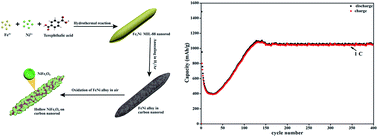Hollow NiFe2O4 nanospheres on carbon nanorods as a highly efficient anode material for lithium ion batteries†
Abstract
The integration of both hollow structure engineering and hybridization to design a novel composite consisting of metal oxides with carbon is highly promising for the anode of lithium ion batteries (LIBs) with high rate capability, remarkable stability, good safety and low cost. In this work, a unique hierarchical structure of NiFe2O4 nanospheres anchored on amorphous carbon nanorods (denoted as NiFe2O4 NSs@CNR) has been synthesized as an anode material for LIBs by using a metal organic framework (MOF) (Fe2Ni MIL-88) as the template and precursor without the addition of external carbon. Combining the hollow structure of NiFe2O4 nanospheres with the carbon nanorod matrix, the as-prepared NiFe2O4 NSs@CNR thus exhibits a superior electrochemical performance, which stabilized at an average capacity of 1355 mA h g−1 after 100 cycles at 0.1C and 1045.6 mA h g−1 after 400 cycles at 1C when evaluated as an anode material for LIBs. More importantly, the hollow NiFe2O4 NSs@CNR shows a long life-span capacity of 513.7 mA h g−1 even at a high rate of 2C after 1000 cycles.



 Please wait while we load your content...
Please wait while we load your content...